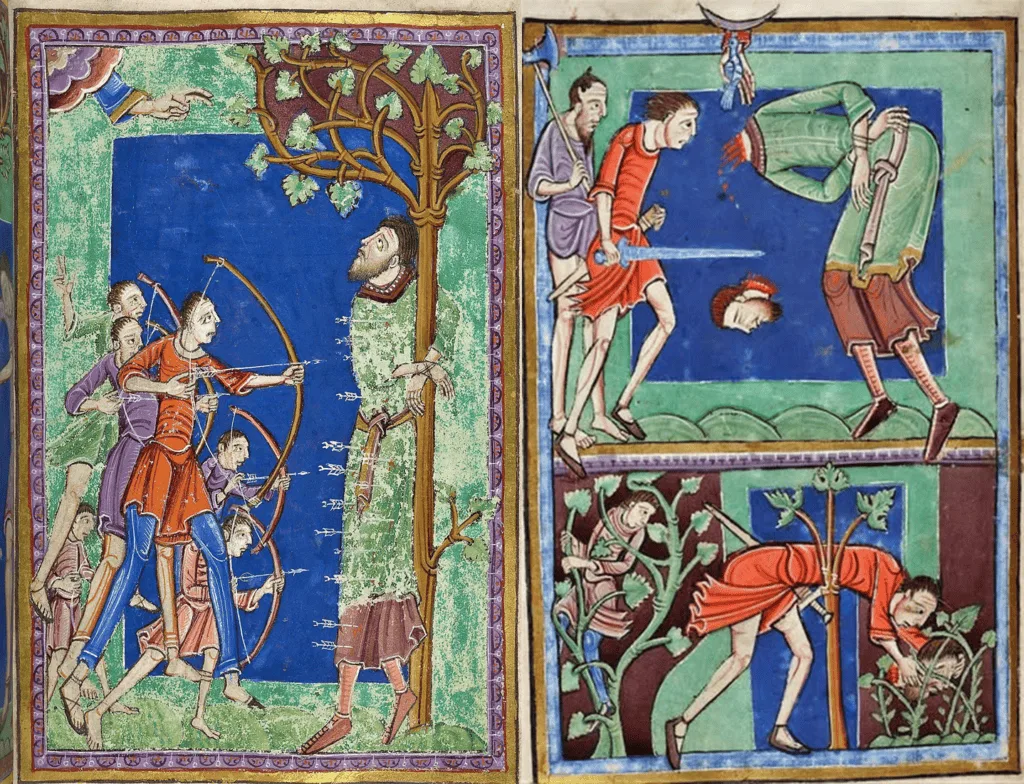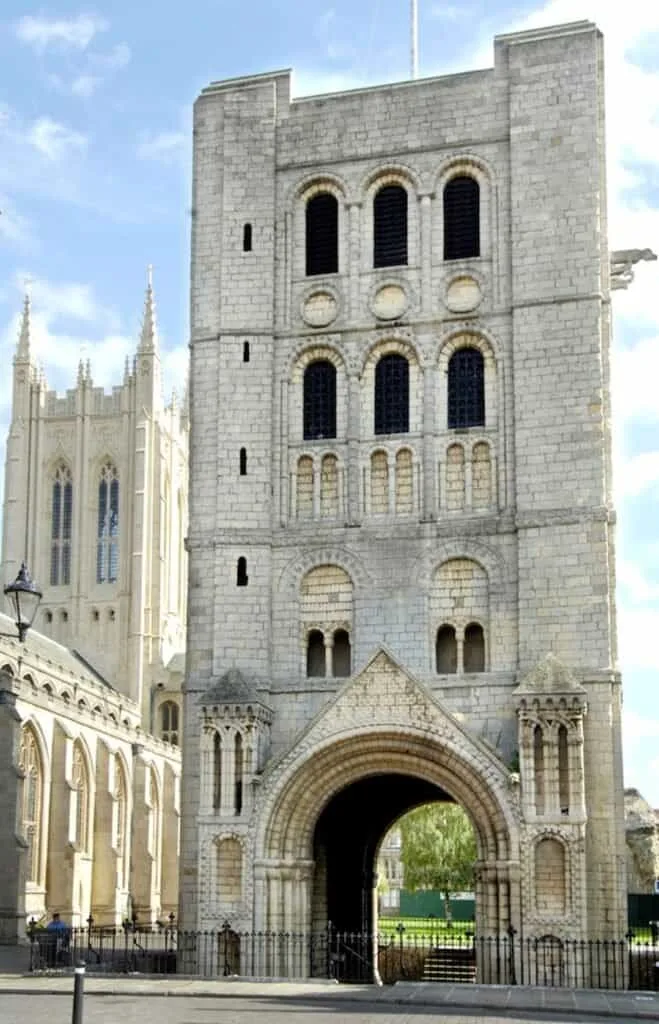
Saint Edmund, King of East Anglia, is one of the most fascinating figures from England’s dark ages history. His life, martyrdom, and the legends that grew around him have captivated generations and made him a symbol of faith, resilience, and sacrifice.
Edmund’s Early Life and Reign
Edmund was born around 841 AD, likely in East Anglia or Saxony. At the age of 14, he was crowned king of East Anglia on Christmas Day in 855 AD. His reign was marked by relative peace and devotion to his Christian faith. Unlike many rulers of his time, Edmund was described as a pious and just king who governed his people with fairness and upheld Christian values.
The kingdom of East Anglia during Edmund’s reign was one of several smaller Anglo-Saxon kingdoms in England. However, its location on the eastern coast made it particularly vulnerable to Viking raids. By the mid-9th century, Danish Viking forces had begun their campaigns across England, leaving devastation in their wake.
The Invasion of the Great Heathen Army

In 869 or 870 AD, the Danish “Great Heathen Army,” led by brothers Ivar the Boneless and Ubba, invaded East Anglia. The Vikings demanded that Edmund renounce his Christian faith and rule as a puppet king under their authority. Refusing to abandon his beliefs or betray his people, Edmund chose resistance over submission.
According to accounts recorded centuries later by Abbo of Fleury in Passio Sancti Eadmundi, Edmund’s refusal enraged the Danes. After a fierce battle near Hoxne in Suffolk, Edmund was captured by Viking forces.
The Martyrdom of Saint Edmund

The details of Edmund’s martyrdom are both tragic and extraordinary. Refusing to renounce Christ even under torture, Edmund was tied to a tree and whipped before being shot with arrows until his body resembled “the bristles of a hedgehog.” Despite this brutal treatment, he continued to call upon Jesus Christ for strength.
Finally, after enduring prolonged suffering, Edmund was beheaded by the Vikings. His severed head was thrown into a dense forest to prevent his followers from giving him a proper Christian burial. This act reflected Viking beliefs that separating head from body would deny a warrior entry into Valhalla.
The Miraculous Recovery of His Head
One of the most famous legends surrounding Saint Edmund is the miraculous recovery of his severed head. According to Passio Sancti Eadmundi, when Edmund’s loyal followers searched for his body in the forest, they were guided by an extraordinary event. As they wandered through the woods calling out for their king, they heard a voice answering “Here! Here! Here!” (in Latin: hic! hic! hic!).
Following the sound, they discovered Edmund’s head guarded between the paws of a large wolf. Remarkably, the wolf did not harm or consume the head but instead protected it from predators until it could be reunited with his body. This miraculous event became one of the defining moments in Edmund’s sainthood.
When Edmund’s head was placed back on his body for burial, another miracle reportedly occurred: his head fused seamlessly with his torso, leaving only a thin red line as evidence of his beheading.
The Cult of Saint Edmund

Edmund’s martyrdom quickly elevated him to sainthood. By the late 9th century, coins were being minted bearing the inscription “Saint Edmund King,” indicating widespread veneration. His burial site at Beodericsworth (modern-day Bury St Edmunds in Suffolk, England) became one of England’s most important pilgrimage destinations.
In 1020 AD, King Canute established a Benedictine monastery at Bury St Edmunds to care for Edmund’s shrine. Over time, this abbey grew into one of the wealthiest and most influential religious institutions in medieval England. Pilgrims flocked to Bury St Edmunds to seek blessings and miracles attributed to Saint Edmund.
Saint Edmund as England’s Patron Saint
For centuries, Saint Edmund was regarded as England’s patron saint. His status reflected not only his martyrdom but also his role as a symbol of resistance against foreign invaders. However, in 1350 AD, Saint George replaced him as England’s patron saint under King Edward III’s reign – a decision influenced by political and cultural factors tied to chivalric ideals.
Despite this change, many have argued for Saint Edmund’s reinstatement as England’s patron saint due to his historical connection to English soil and identity. In contrast, St. George was not English and never came to the land, and few facts are really known about him.
Miracles Associated with Saint Edmund
Numerous miracles have been attributed to Saint Edmund over the centuries:
- The Healing Blind Man: Shortly after his death, a blind man reportedly regained his sight after spending a night near Edmund’s makeshift shrine.
- Incorrupt Body: When exhumed decades after his burial, Edmund’s body was found incorrupt—his wounds healed except for faint scars where arrows had pierced him.
- Protection During War: During times of conflict, soldiers prayed at Saint Edmund’s shrine for protection and victory.
- The Wolf Guardian: The story of the wolf protecting Edmund’s head became an enduring symbol of divine intervention.
Legacy in Modern Times
Though overshadowed by Saint George in official recognition, Saint Edmund remains an important figure in English history and spirituality. The town of Bury St Edmunds continues to celebrate its connection to its namesake with festivals and events. From his defiance against Viking invaders to the miraculous tales surrounding his death and sainthood, he remains an enduring symbol of resilience in English history.

St. Edmundsbury Cathedral today, Bury St. Edmund, Suffolk, UK.
St. Edmund’s burial location remains a mystery. His remains were originally kept in a shrine at the Abbey in Bury St Edmunds but were lost during Henry VIII’s dissolution of the monasteries in the 16th century. Historians speculate he might have been quietly moved by monks to an unknown location within the Abbey precincts.





Oh how I wish we had a saint Edmund now
My Children were born in Bury St Edmund’s and went to School there. We regularly visited the Abbey. It is indeed a very tranquil park, and very atmospheric, although there are few remains remaining, just heaps of stones covered with grass. Children love this park, and it is an important Abbey. Thank you for sharing the story of St Edmunds. An insight to a very brave and holy King.